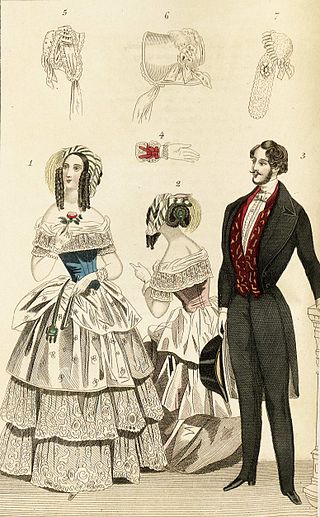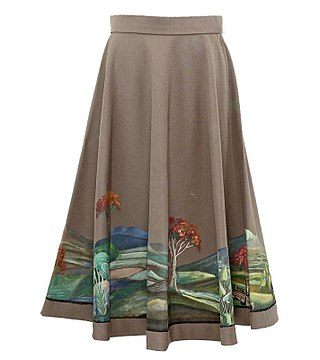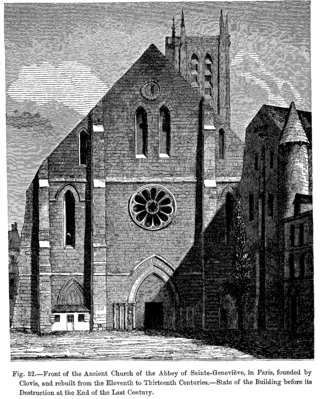Related Research Articles

Jason was an ancient Greek mythological hero and leader of the Argonauts, whose quest for the Golden Fleece featured in Greek literature. He was the son of Aeson, the rightful king of Iolcos. He was married to the sorceress Medea. He was also the great-grandson of the messenger god Hermes, through his mother's side.

The Panthéon is a monument in the 5th arrondissement of Paris, France. It stands in the Latin Quarter, atop the Montagne Sainte-Geneviève, in the centre of the Place du Panthéon, which was named after it. The edifice was built between 1758 and 1790, from designs by Jacques-Germain Soufflot, at the behest of King Louis XV of France; the king intended it as a church dedicated to Saint Genevieve, Paris's patron saint, whose relics were to be housed in the church. Neither Soufflot nor Louis XV lived to see the church completed.

A masquerade ball is a special kind of formal ball which many participants attend in costume wearing masks. Less formal "costume parties" may be a descendant of this tradition. A masquerade ball usually encompasses music and dancing. These nighttime events are used for entertainment and celebrations.

The Argonauts were a band of heroes in Greek mythology, who in the years before the Trojan War accompanied Jason to Colchis in his quest to find the Golden Fleece. Their name comes from their ship, Argo, named after its builder, Argus. They were sometimes called Minyans, after a prehistoric tribe in the area.

A hamadryad or hamadryas is a Greek mythological being that lives in trees. It is a particular type of dryad which, in turn, is a particular type of nymph. Hamadryads are born bonded to a certain tree on which its life depends. Some maintain that a hamadryad is the tree itself, with a normal dryad being simply the indwelling entity, or spirit, of the tree. If the tree should die, the hamadryad associated with it would die as well. For this reason, both dryads and the other gods would punish mortals who harmed trees.
Enyalius or Enyalios in Greek mythology is generally a son of Ares by Enyo and also a byname of Ares the god of war. Though Enyalius as a by-name of Ares is the most accepted version, in Mycenaean times Ares and Enyalius were considered separate deities. Enyalius is often seen as the God of soldiers and warriors from Ares cult. On the Mycenaean Greek Linear B KN V 52 tablet, the name 𐀁𐀝𐀷𐀪𐀍, e-nu-wa-ri-jo, has been interpreted to refer to this same Enyalios. It has been suggested that the name of Enyalius ultimately represents an Anatolian loanword, although alternative hypotheses treat it as an inherited Indo-European compound or a borrowing from an indigenous language of Crete.

Victorian fashion consists of the various fashions and trends in British culture that emerged and developed in the United Kingdom and the British Empire throughout the Victorian era, roughly from the 1830s through the 1890s. The period saw many changes in fashion, including changes in styles, fashion technology and the methods of distribution. Various movement in architecture, literature, and the decorative and visual arts as well as a changing perception of gender roles also influenced fashion.

A skirt is the lower part of a dress or a separate outer garment that covers a person from the waist downwards.

Ready-to-wear (RTW) – also called prêt-à-porter, or off-the-rack or off-the-peg in casual use – is the term for garments sold in finished condition in standardized sizes, as distinct from made-to-measure or bespoke clothing tailored to a particular person's frame. In other words, it is a piece of clothing that was mass produced in different sizes and sold that way instead of it being designed and sewn for one person. The term off-the-peg is sometimes used for items other than clothing, such as handbags. It is the opposite of haute couture.

The Toronto Argonauts are a professional Canadian football team competing in the East Division of the Canadian Football League (CFL), based in Toronto, Ontario. Founded in 1873, the team is the oldest existing professional sports team in North America still using its original name, as well as the oldest-surviving team in both the modern-day CFL and East Division. The team's origins date back to a modified version of rugby football that emerged in North America in the latter half of the 19th century. The Argonauts played their home games at Rogers Centre from 1989 until 2016, when the team moved to BMO Field, the fifth stadium site to host the team.

A dress code is a set of rules, often written, with regard to what clothing groups of people must wear. Dress codes are created out of social perceptions and norms, and vary based on purpose, circumstances, and occasions. Different societies and cultures are likely to have different dress codes, Western dress codes being a prominent example.

Fashion in the period 1700–1750 in European and European-influenced countries is characterized by a widening silhouette for both men and women following the tall, narrow look of the 1680s and 90s. This era is defined as late Baroque/Rococo style. The new fashion trends introduced during this era had a greater impact on society, affecting not only royalty and aristocrats, but also middle and even lower classes. Clothing during this time can be characterized by soft pastels, light, airy, and asymmetrical designs, and playful styles. Wigs remained essential for men and women of substance, and were often white; natural hair was powdered to achieve the fashionable look. The costume of the eighteenth century, if lacking in the refinement and grace of earlier times, was distinctly quaint and picturesque.

Fashion of the 1960s featured a number of diverse trends, as part of a decade that broke many fashion traditions, adopted new cultures, and launched a new age of social movements. Around the middle of the decade, fashions arising from small pockets of young people in a few urban centers received large amounts of media publicity, and began to heavily influence both the haute couture of elite designers and the mass-market manufacturers. Examples include the mini skirt, culottes, go-go boots, and more experimental fashions, less often seen on the street, such as curved PVC dresses and other PVC clothes.

The Abbey of Saint Genevieve was a monastery in Paris. Reportedly built by Clovis, King of the Franks in 502, it became a centre of religious scholarship in the Middle Ages. It was suppressed at the time of the French Revolution.
Metrosexual is a term describing a man in an Urban area culture who is especially meticulous and scrupulous about his personal style, grooming and appearance. It is often used to refer to heterosexual men who are perceived to be effeminate rather than strictly adhering to stereotypical masculinity standards. Nevertheless, the term is generally ambiguous on the gender and sexual orientation of a man as it can apply to cisgender, transgender, heterosexual, gay or bisexual men. Some academics consider metrosexuals to be exhibiting narcissistic tendencies.
Argia, Argea, or Argeia may refer to several figures in Greek mythology:
In Greek mythology, Pyracmus was a king of Euboea during the Heroic Age. After waging war against Boeotia, he was slain by Heracles.

Fashion in the twenty years between 1775 and 1795 in Western culture became simpler and less elaborate. These changes were a result of emerging modern ideals of selfhood, the declining fashionability of highly elaborate Rococo styles, and the widespread embrace of the rationalistic or "classical" ideals of Enlightenment philosophes.

Fashion and clothing in the Philippines refers to the way the people of the Philippine society generally dress up at home, at work, travelling and during special occasions.
Phalanx is a minor Attic figure in Greek mythology who features in a lesser-known narrative of the myth of Arachne, the girl who enraged the goddess Athena by boasting of being a better weaver than her and was thus transformed into a spider by Athena. In this version of the story, Phalanx is Arachne's brother, and they are both punished by the goddess when they break a societal taboo.
References
- ↑ Bell, John (1790). "Hybristica". Bell's New pantheon. London.
This article incorporates text from the 1790 Bell's New pantheon article "Hybristica", a publication now in the public domain.